This year we have supported 80 people of an Amazon training program from the U.S. They needed our help to import from China and ship to Amazon’s FBA center. Although they are new to this business, they really focus on designing own packaging and adding private label to every single product for branding strategy.
There are too many articles on Internet telling people advantages of private labeling, but no one shares their experience about “how to do”, or “how much it costs” for private labeling products when import from China.
As my team helped these new Amazon sellers add private labeling for products in various categories, we have derived 11 most common solutions for adding your label/logo on products in this article. You will learn many ideas about how to add own brand on products.
What is a Private Label? Why It’s Important for New Business?
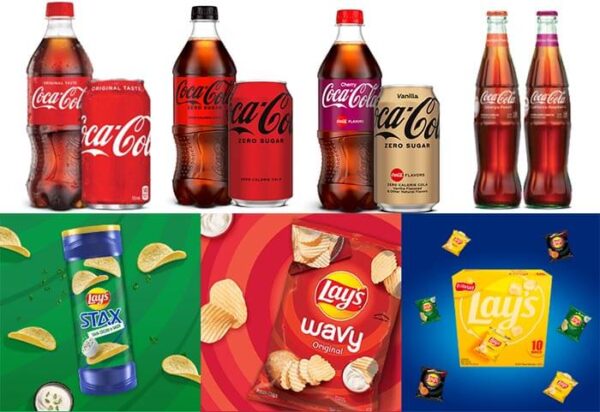
Private label is the logo or pattern on products manufactured by a contract or third-party manufacturer and sold under a retailer’s brand, it represents the seller and helps build customer loyalty.
If you want to start a business that imports from China and sell on an online marketplace like Amazon, here’s the simplest and best way to do it: find a good product or a product niche with limited existing competitors, choose quality items from China, add a private label on the product, and start to market the product under your brand.
Private labeling is the best way for customers to distinguish your products from others. If your products are always built with high quality and good design, customers will pay higher prices and stay loyal to your brand. And of course, your margin will be way much larger than selling nationally branded goods or your supplier’s brand.
Add Your Private Label on Product & Packaging
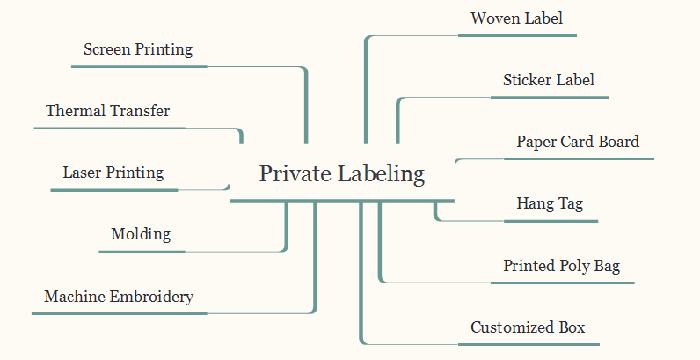
For most categories products, you can add a private label (your logo) on product body or packaging. I have concluded 11 main solutions for private labeling that my team has dealt with all kinds products for our clients, and they are listed in the above graphic.
The five solutions in the left part of this graphic are for adding your logo on the product. These solutions are applied to products made from different materials. The six solutions in the right side are ideas to add your private label on product packaging.
Below, I will introduce all 11 solutions clearly, and also let you know the estimated cost for each solution in China. By learning all of these, you will not be overcharged by Chinese suppliers, and you will get ideas about how to add private label on your products.
Solution 1: Screen Printing (or Silk Screen)

Screen printing is the most common and widely used method for adding a private label on both product body and packaging. It can be applied to products made from almost all kinds of materials such as plastic toys, glass bottles, stainless cups, rubber dumbbells, etc. If you are buying more than 500pcs/item, using screen printing is the easiest and cheapest way to add your private label.
Most Chinese factories can offer screen printing services for free if you can buy more than $2,000/item. Or they will charge you around $60 fee for creating a printing plate of your logo, and around $0.02/product labor fee for printing. If the supplier doesn’t offer the service, you can easily find a printing supplier in China to do the job.
The only drawback of screen printing is that it’s not suitable for multi-colored patterns, especially gradient color design. If you want to print your gradient color logo on products, you have to think about the thermal transfer. Or you need to find other solutions than printing.
Solution 2: Thermal Transfer

Thermal transfer printing process is more complicated than silk printing and it requires a temperature range from 140℃ to 180℃. Therefore, it’s a little bit more expensive than silk printing and has some restrictions on materials. It’s applicable to ABS, PE, PP, EVA, leather, stainless steel, wood, glass, etc.
If you have a really fancy pattern with gradient color, the thermal transfer would be your best choice. Last year my team helped a domestic company in China to print their logo on a nonwoven bag via thermal transfer. The cost is around $100 for creating the printing plate and the $0.04 printing fee for the 7x7cm size gradient color logo. You can use this case as a reference.
Solution 3: Laser Printing / Engraving

Laser printing, or laser engraving, gives your product a rather high-quality appearance. If you take a good look in the market, you’ll see almost every gift store is filled with items with laser-printed logos, words, or patterns. Personally, I like buying a present with my friend’s name and a lovely sentence on it and laser engraving works perfectly for this purpose.
Usually, it doesn’t require huge MOQ as there’s no need for plate making. My supplier only charged me less than one dollar to laser my client’s logo on a stainless steel bottle sample two weeks ago. For mass production, it may cost you $0.01-$0.15/unit, depending on the quantity and size.
Solution 4: Molding
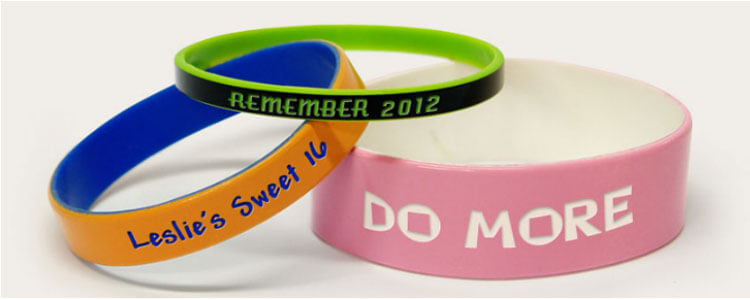
The solution molding is to make your private label in the product mold, which means the logo is there when the product comes out from the machine, and this solution can be applied to all plastic, rubber, or metal-made products. Among all molding types, injection molding is most commonly used.
The advantage of this solution is your private label looks more natural and has higher quality than printing, but the high cost is its primary disadvantage. Customizing your logo in a product mold means you need to change the supplier’s mold or even create a brand new mold. And you will absolutely not choose this solution when you are not buying big quantities.
In my experience, there’s no extra cost to make the molding private label, but the factory will charge you a fee for changing mold or creating mold, and the price depends on the products. Usually, a mold for plastic items costs $1,000 to $3,000, and mold for metal products needs $500 to $1,000.
Creating molds also needs 15 to 20 days, which means it takes much longer time than other solutions.
Solution 5: Machine Embroidery
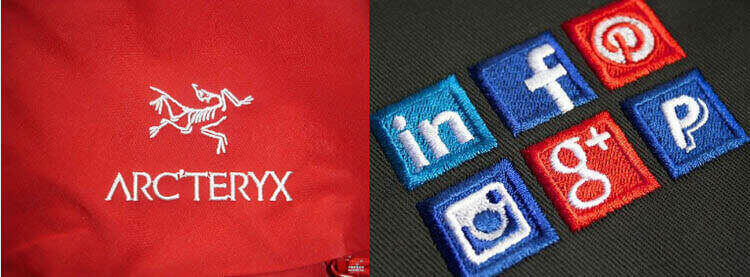
Embroidery is mainly applied to items made of cloth, such as garments, caps, and bags. It’s more durable and appears higher level compared to silk printed logos, and there are no color fading problems with this solution. However, it costs more than screen printing.
I prefer to sort embroidery into two types. The first type is to embroider the logo directly on product (like the ARCTERYX on above picture). But it’s not quite suitable for very small and complex logos. By my experience, an embroidery like this in 4x5cm size is about $0.2.
The second type is to make a patch (like the right side of above image) and sew it on product. Normally the embroidery factories make these patches and sell them to garment manufacturers. This way allows multi-color and complicate patterns, such as football team badge, national flag, logo of motor corporation, etc. Most vendors have minimum order amount of $50. The unit price for a 5cm x 6cm logo with four colors is like $0.12.
Solution 6: Woven Label
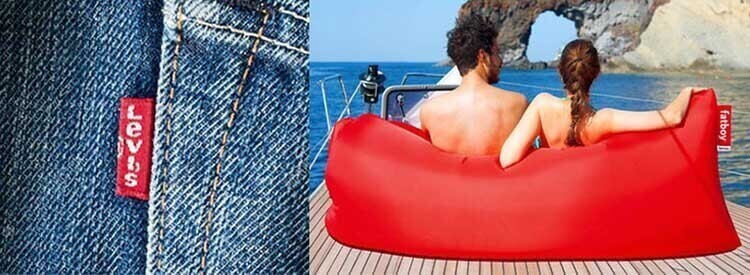
Normally woven labels are sewed at the edge of fabric made items, like shoes, jeans, hats and bags. This label looks way better then printed logos. If your product is made of or partially made of fabric, it’ll be a nice try to add your logo on a woven label even if your competitors don’t do it like this. You can sew your woven label on sleeping bag, tent or even on umbrella to make it unique. For example, the hot selling Lamzac Hangout Air Lounge has a huge woven label on the side. It does look nicer than printing logos and the color wouldn’t fade as well.
The price is always related to the size and quantities. Lets’ say we do a 3x4cm size woven label. The MOQ is normally 1000 pieces with a unit price around $0.1.
Solution 7: Sticker Label
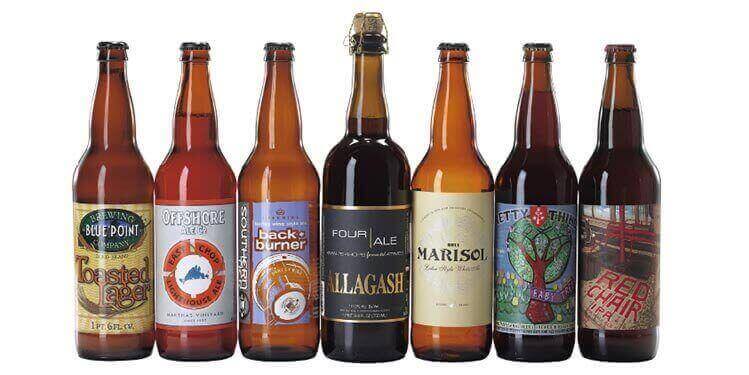
Sticker label is absolutely the simplest, cheapest and the most widely used way among all solutions. I really cannot think of anything that can’t be labeled with a sticker.
It’s quite easy to find sticker vendors who can help you print different shapes and sizes of stickers. Usually the MOQ is just $40 to $50 for one design. You’re able to get 3,000 pieces of stickers like above pic within this cost range. But if you just want 500 stickers, they might not agree to do that for you.
If you only order 500 products and get 3000 pieces of customized sticker label, it’s ok to leave the remaining stickers with your product manufacturer. This means you’ll probably buy more goods from them in near future. They’ll be happy to keep stickers for you.
Solution 8: Paper Cardboard
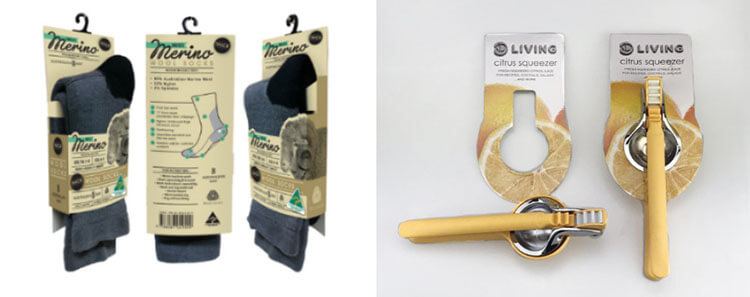
If your budget for packaging is limited, you don’t want to spend $0.2 or $0.3 to make a box for your goods, and you don’t want to make stickers and devalue your product, then I think you may consider trying another option – paper cardboard. Print your private label and all other information on a cardboard and pack your goods with it.
Paper cardboard is the best option for low cost items like socks. It’s about $0.35 to buy a pair of sock from China, and the paper cardboard is around $0.03/pc.
Typically retailers prefer using paper cardboard for tool or kitchen products category because it enables customers to see the product easily. For example, the Lemon Sqeezer in the image above is packed with a simple printed paper cardboard and costs around $0.08/pc.
Solution 9: Hang Tag
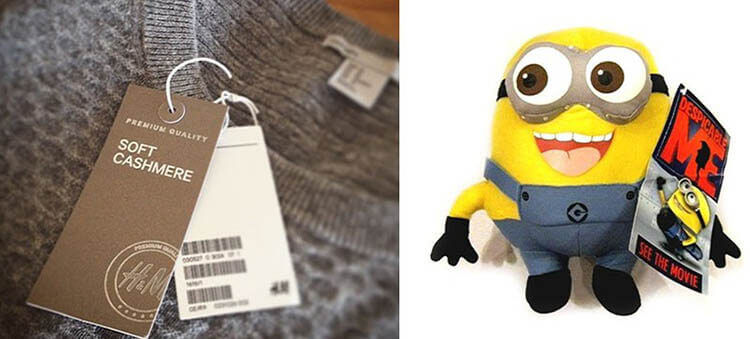
Hang tag is also one of the most economical ways to private label. It’s usually applied to categories like apparels, toys, tools, fashion jewelries, etc.
Many clothes and jewelries brands select the hang tag to present their label. Usually it’s made of ivory cardboard or kraft, sometimes made of plastic or even metal. In fact, many people choose to use 300gsm ivory cardboard most because of it’s economical (the same material of most business card you get from Chinese trade shows).
Solution 10: Printed Poly Bag
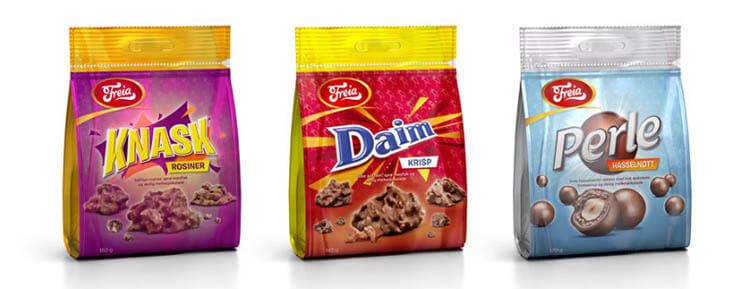
This is actually a type of packaging. And it’s also a way to add private labels. Comparing with other packing method, printed poly bag is kind of simple for large quantity goods. As the printing plate is about $80/color, manufacturers usually demand tens of thousands as MOQ. If you are not planning to buy the product of this quantity, choose other private label solutions will be much better.
Solutions 11: Customized Box

Making your own design and printing it on a customized box is suitable for almost all product. Surely it’s the most expensive solution among these 11 ways. A nice fancy box can easily make your product look great. It’s also a way to add extra value and sell with a higher price.
Box packaging is a very large industry. The price is related to different material, technique and machinery. Take the cheapest box – corrugated case as example, for 3000 pcs of 8”x4”x4” corrugated case with your pattern on it, the unit price is around $0.16. If you want to do a firm one like the Iphone box, it might cost you at least $0.75 each.
If you want to make your own design and don’t know from where to start, creativemarket.com will be a good place for getting some hints. You’ll be able to download your favorite elements and find a freelancer on websites like upwork.com or fiverr.com to help you on the designs.
- Small-Business Affordable Custom Packaging with Great Design
- Right Private Label Products for Small Business (5 Inspiring Examples)
- Find Private Label Suppliers | Expert Tips for Small Business
- Private vs White Label: Customization, Costs, Examples
- What is White Label Products with Examples & Real Cases
- 47 Best Private Label Products to Sell and Make Money
In the End
I’m Jing, the founder of Jingsourcing. We help people source and customize products from China. If you need our help, feel free to contact us.

Great article, thanks for posting this informative post, its very helpful for me.
Good, precise and informative blog content. Thank you for sharing your ideas with us.
Thank you for your support, we are very happy to hear that you enjoy this post. If you have any problem, please feel free to contact us.
Nice post thanks for sharing.
Thank you for your comment, Johnson. We will try to share more informative articles.
Hi so i have a question regarding cosmetics ( face sheet mask in particular )
If i buy a product from china would it be allowed to re pakage the product with my brand on it ?
Sure, it is allowed and if you need, we can help you.
That would be great
Nice Post your article is very Unique
Thanks, we appreciate it!
This post is really insightful, I learned a lot that I never known before.
Hi, thanks for appreciating the post, we will create better content for you.
There are many big companies who have used private branding so it is very good way to get more profit and with this you can even save time. You included some of the information which i did not knew before.
Thanks for your comment, so glad you like this post, we will create more useful content for you in the future.
Great article, one thing I would add is that often people will let the MOQ for packaging materials inform how much product they purchase. This makes sense from a manufacturers perspective, but as a private business, it’s often perfectly OK to hold onto excess packaging instead of using it all at once. It depends on what type of packaging though, as you want to avoid packaging that has an expiry.
Also, for large MOQs, choosing the right shipping provider is pretty important, as items that are either bulky or heavy, shipping costs can eat into profit margins quickly.
I believe that custom label printing can make your brand stand out among the rest. I like what you said about paying for a high- quality and good design. My friend wants to start a sock company, so I’ll suggest he find a custom printing service that can make unique labels.
Thanks for your comment! Glad you like our post. If you need a custom printing service, our support can help you with that. You can check your email for contacting if you need.
I am considering adding a private label supplement to my online store. THank you for this information.e
Thanks for your comment. Glad you like the post.
Just Read your article all solutions are goods for private label great post keep sharing
Private label products have a higher profit margin than products that you just resale. I have looked into private label skincare line.
Great Job!! This article gives a lot of information regarding Label & Product & Packaging .This information is very useful for us.Thanks for sharing this post.
Great Job!! This article gives a lot of information regarding Label & Product & Packaging .This information is very useful for us.Thanks for sharing this post.
Good Article, it is very comfortable to read your words.
Anyway I can contact you guys via any instant messaging platform like whatsapp or wechat. I’m not too good with emails.
hi, Ikenna, welcome, actually the process is you submit your inquiry (there is a button on our home page) first with the detailed info of the products you want to source, once we receive your inquiry and confirmed that your products are within our scope, an sourcing agent will then be assigned to you, you can contact your agent via any other instant messaging tools like whatsapp, skype, or even wechat you prefer in the following process.
This answered part of my question. Thank you
perfect.
I like your point
Great information – thank you, Zhu Jing!
I like your comment
What is a good company to use for printing custom boxes?
I like your comment